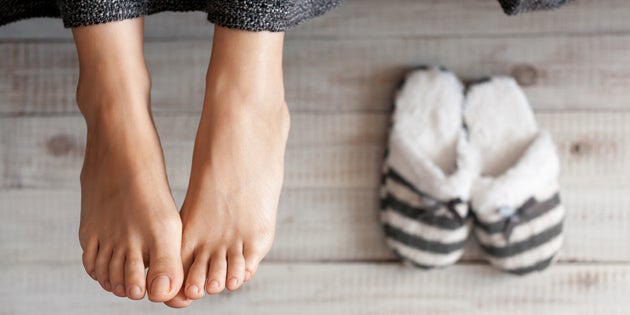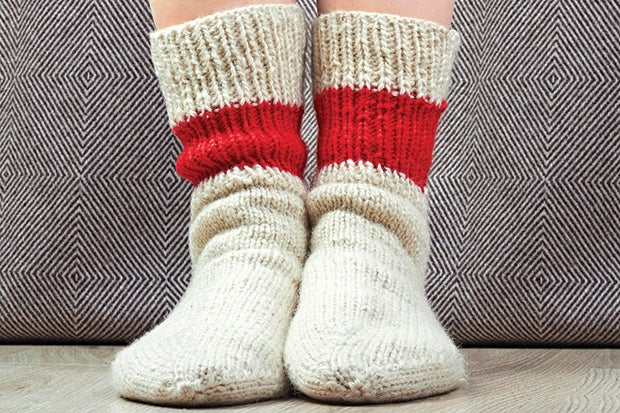Heading out the door? Read this article on the new Outside+ app available now on iOS devices for members! Download the app.

Suffice to say that as an active woman, your feet, which surprisingly house 25 percent of your muscles, are your most important bodypart. They’re so well-used, in fact, that by the time most people turn 50, they’ve logged 75,000 miles on their feet, according to the American Podiatric Medical Association.
That could explain why those dogs talk back, sometimes more than you’d like. So what are some of their most common complaints? Take a look at the following five scenarios and get the scoop on how to solve and prevent these foot crises, ultimately giving your feet the love they deserve.
1. Your feet fall asleep while you’re doing cardio.
What’s going on: Your feet are lacking circulation, usually caused by improperly fitted shoes, says Katy Bowman, biomechanist in Seattle and author of Whole Body Barefoot (Propriometrics Press, 2015).
Related:Weak In The Knees?
The foot fix: Check that your workout shoes aren’t too small or tied too tight. You should be able to fit a finger under your shoelace. Then take out the insert in your shoe and step on it. If any part of your foot hangs over, your shoes are too small, says Johanna Youner, DPM, board-certified foot doctor and surgeon in New York City.
Prevention plan: When shopping for shoes, go right after a workout because that’s when your feet are largest, Bowman says. Any shoe you stand in should be a ½ inch longer than your toes. Also, simulate your workout movements in the store so you can feel how the shoe moves. In fact, take them for a test drive — jog around the store! If it’s tight on the sides or doesn’t let you spread your toes, look for one with a wider toe box.
2. You’re battling tightness in your lower leg that won’t go away.
What’s going on: What’s going on: Those heels you sport at work could be screwing up your calf muscles. When you wear heels, your calf muscles actually shorten, which then causes a myriad of problems, including loss of joint range of motion and muscle length in your legs, which can lead to injury. Physical activities that put you on the balls of your feet also could be an issue here.
The foot fix: Decrease or eliminate your time in high heels, Bowman says. Can’t part with those heels? After 3 p.m., switch to lower-heeled shoes, especially if you’re logging an after-work sweat. “Giving your feet that time off from heels will make the transition into workout shoes less drastic and damaging on your calf muscles,” she adds. If that’s not an option, extend your preworkout warm-up by five or 10 minutes.
Prevention plan: Once you’ve cut your heel time, vary your workouts so you’re not always doing activities like the StairMaster and elliptical that put you on the balls of your feet.
3. You’ve got an annoying blister on the back of your heel.
What’s going on: Rubbing of the heel counter to your shoe can cause abrasion that leads to a blister. The most common culprit? Shoes that aren’t properly fitted or the shoe’s design, in this case a heel area that might be too wide, says Rick Mende, director of research for the Institute for Preventive Foot Health in Statesville, North Carolina.
The foot fix: Although you might be tempted, avoid popping that blister, especially if you have diabetes. “Otherwise, you could risk infection,” Mende says. Instead, cover it with moleskin or a specially padded bandage. In a pinch? Use duct tape. If your skin breaks, apply an antibiotic ointment to prevent infection.
If, though, the blister is large and seriously interferes with your movement, especially if your feet are your only transport and you need to move, you can pop and drain it. Just do it within 24 hours of getting it so you start the healing process. Some tips: Sterilize a needle (rub with alcohol or place it over a flame), pop the blister from the side without twisting the needle, make a few holes in different sides and squeeze out the fluid. After, seal it with glycerin gel lubricant, dab with antibiotic ointment and cover with a bandage.
Prevention plan: Wear padded socks and properly fitted shoes, Mende says. Also, if you’re hiking in wet or damp conditions, change your socks at least once a day.

4. Your heel is on fire, especially when you take that first step in the morning.
What’s going on: You could have plantar fasciitis, a painful inflammation in the tissue that connects your heel bone to the base of your toes. That inflammation, common in people who run or jump a lot or those with very flat feet or high arches, can get worse if you’re wearing unsupportive shoes or the wrong shoes for your activity, Youner says.
The foot fix: Seek medical attention, especially if the pain interferes with daily activities. Your doctor may recommend an orthotic, which can ease stretching and stress of the plantar fasciitis. You also should curtail high-impact activities and veer toward low- or no-impact activities. Ice the affected area for 10 minutes on, 20 minutes off, several times a day, and do simple stretches. Try, for instance, the seated stretch in which you sit on the floor with your legs extended in front, towel wrapped around the ball of the affected foot, and pull your forefoot toward you, keeping your heel on the floor; hold 20 to 30 seconds and repeat three times.
Prevention plan: Make sure you’re using the right shoe for your activities. “And if you’re a runner or high-mileage walker, change shoes at least every eight months,” Youner says.
5. You’ve developed the dreaded black toe.
What’s going on: In most cases, blame trauma to the nail, especially if you’re a runner, walker, hiker or soccer player. If you’re wearing a shoe that’s too small or tight, your foot doesn’t have enough space to move in the shoe. Your toes, especially that big toe, then slam into the shoe, causing the nail to bruise and bleed. The normal back-and-forth motion of the toe in the shoe also can cause this.
The foot fix: See a doctor. “The blood needs to be removed from the nail so it doesn’t create permanent nail injury,” Youner says. And don’t worry if the nail falls off; it’ll grow back.
Prevention plan: Check that shoes are properly fitted to your feet. Padded socks, tube foam toe bandages and silicone toe-cap pads also can keep this from being a recurring problem.
Please note:
If at any point you do suffer an injury to your feet or see a change in your feet,
seek medical advice.